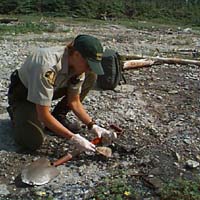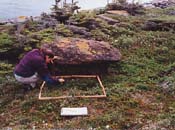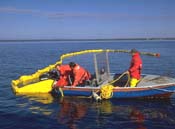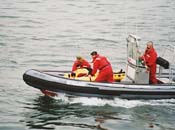The conservation service
Mingan Archipelago National Park Reserve

Park Warden
© Parks Canada / S. Malouin, 1999
The activities of the Ecosystems Conservation and Heritage Presentation Service reflect Parks Canada's basic mandate, which is to promote its resources for the benefit of all Canadians while protecting the ecological integrity of its national parks.
An important role thus falls upon the Conservation Service team: that of protecting the park's natural resources. In this capacity, the team is responsible for different programs which include natural resource management, protection of the environment, public safety and application of the law.
Maintaining the park's ecological integrity is a shared responsibility. The team is better able to protect the ecosystems and conserve the unique character of this national park reserve by combining its conservation efforts with those of the public and local residents.
- Managing Natural Resources
- Protection of the Environment
- Ensuring Public Safety
- Application of the Law: Prevention and Awareness
Managing Natural Resources

Vegetation Study
© Parks Canada / N. Dénommée, 2000
Often unique and greatly diverse, the Mingan Islands' fauna and flora are exceptional resources. All the same, they remain vulnerable to different stress factors coming from within the park as well as from the outside. These factors include a growing rate of tourism, the unlawful removal of living organisms, pollution, and commercial development of the terrain.
Increasing our knowledge of our environmental resources - a situation which allows for enlightened decision-making and consideration of the appropriate protection measures - is vital to maintaining the park's ecological integrity. To better understand the state of the park's animal and vegetal populations, the Conservation Service conducts many scientific studies .
Without scientific evidence, it is often impossible to determine the impact of natural changes or human activities on the environment.

Oil spill simulation
© Parks Canada / D. Quann / W 06 52, 1994
Protection of the Environment
Not only is the environment protected by the National Parks Act, it is also safeguarded by measures aimed at preventing forest fires and maritime pollution.
The park is not exempt from forest fires, whether of natural or human origin. In their efforts to prevent forest fires on the islands, the Conservation Service team follows the fire weather index, and keeps the public informed on a daily basis.
The park is situated in a busy maritime transport zone. As its shoreline is particularly vulnerable to toxic spills, the Service is ready to intervene in the event of an emergency.
Training courses, practical and theory courses, and simulation exercises keep the conservation team poised to administer a rapid and efficient response should human or natural catastrophe arise in the national park reserve.
Ensuring Public Safety

Search and Rescue Simulation
© Parks Canada / R. Quenneville
To protect all those frequenting the park, the Conservation Service oversees activities set up for incident prevention, and are the first to intervene in the park in the event of an emergency. They are trained in first aid, in transporting the injured or in conducting search and rescue operations both on the water and on land.
Application of the Law: Prevention and Awareness
In keeping with their mandate of conserving the park's natural and historical heritage, the Conservation Service aims to ensure that regulations and other associated laws are respected in the national parks.
All the same, prevention and awareness remain the greatest challenges. Signposting, disseminating information and education are simple and effective means of sensitizing both young and old to the park's conservation issues.
- Date modified :